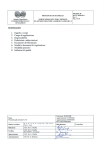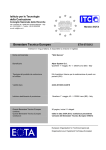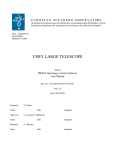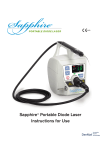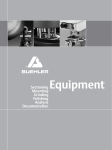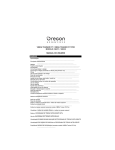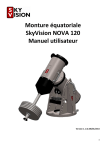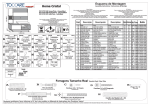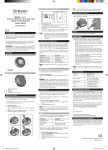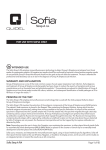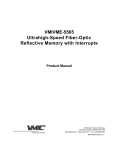Download VLT-TRE-ESO-15730-4546-PRIMET safety and reliability
Transcript
EUROPEAN SOUTHERN OBSERVATORY Organisation Européenne pour des Recherches Astronomiques dans l’Hémisphere Austral Europäische Organisation für astronomische Forschung in der südlichen Hemisphäre VERY LARGE TELESCOPE Prima Metrology Safety and Reliability Analysis Doc. No VLT-TRE-ESO-15730-4546 Issue 1 Date 02/04/08 Prepared . .S.Leveque .................................................................. Name Date Signature Approved .F.Delplancke/M.Boecker .................................................................. Name Date Signature Released . .R.Gilmozzi .................................................................. Name Date VLT PROGRAMME — TELEPHONE: (089) 3 20 06–0 — FAX: (089) 3 20 23 62 Signature Prima Metrology Safety and Reliability Analysis Doc Issue Date Page VLT-TRE-ESO-15730-4546 1 02/04/08 1 of 23 Change Record Issue / Rev. Date Section / Page. affected 1 02/04/08 all Reason/Remarks Prima Metrology Safety and Reliability Analysis Doc Issue Date Page VLT-TRE-ESO-15730-4546 1 02/04/08 2 of 23 Table of Contents 1 2 3 4 5 Scope .................................................................................. 3 Applicable and reference Documents ............................... 3 Acronyms ........................................................................... 3 Description of PRIMET ..................................................... 4 PRIMET Safety ................................................................. 8 5.1 List of possible hazards ............................................................ 8 5.2 Laser Hazards and Safety Interlock system ........................... 9 5.2.1 Introduction ................................................................... 9 5.2.2 PRIMET Laser source and specification for eye protection 9 5.2.3 PRIMET laser beam propagation and power levels .. 12 5.2.4 Protection against laser hazards ................................ 13 5.2.5 Laser Interlock system based on safety PLC’s ........... 14 5.3 Hazard Identification and Risk Estimation .......................... 20 6 7 8 9 PRIMET Reliability ......................................................... 21 PRIMET preventive maintenance .................................. 23 Actions after an Earthquake .......................................... 23 Prima Metrology Safety and Reliability Analysis 1 Doc Issue Date Page VLT-TRE-ESO-15730-4546 1 02/04/08 3 of 23 Scope This documents presents the safety analysis for the PRIMA Laser metrology system (PRIMET) as well as the implementation of the safety equipment required to operate it, based on AD 1 and AD 2. It addresses hazards to PRIMET and to personnel during installation, commissioning, maintenance and operation at Paranal. This document also includes an estimation of the reliability of PRIMET based on information provided by the manufacturers of some PRIMET components, based on the experience gained during the testing of PRIMET in Garching and on other ESO instruments. Preventive maintenance activities and a spare parts are listed. 2 Applicable and reference Documents AD 1 Safety conformity assessment procedure, SAF-INS-ESO-00000-3444, issue 1, 10/10/2006 AD 2 ESO General Safety regulations, Laser safety, SAF-INS-ESO-00000-0011, Issue 1 AD 3 Electronic Design Specifications-SPE-ESO-10000-0015, issue 6, 8/12/2005 AD 4 Design Description of the PRIMA Metrology System, VLT-TRE-ESO-15730-3000, Issue 1, March ‘03 AD 5 As built Phase Meter configuration for the PRIMA Metrology System, VLT-TRE-IMT-15734-3726, issue 1, 20.7.2005. AD 6 Design of the Laser Assembly of the PRIMA Metrology System, VLT-TRE-IMT-15731-3154, issue 4, 19/12/2003. AD 7 Prima Metrology Control Electronics, VLT-TRE-ESO-15735-2963, issue 2 AD 8 User Manual Mephisto Laser (www.innolight.de) AD 9 User Manual: Diode-pumped Fiber-coupled Non planar Ring laser, Model 125-1319-200, Lightwave Electronics. AD 10 Prima Metrology Test report, VLT-TRE-ESO-15730-4042 RD 1 ESO Garching Laser Safety Instruction, SAF-PRO-ESO-00000-3511, issue 1,2/2/2006 RD 2 Design of the PRIMA Metrology Interlock System, VLT-TRE-ESO-15735-4544, issue 1 April 2008 3 Acronyms MPE: Maximum permissible exposure limit MTBF: Mean Time Between Failure MTTR: Mean time to repair N/A: Not Applicable PV: Peak-to-Valley TBC: To Be Confirmed TBD: To Be Defined Prima Metrology Safety and Reliability Analysis 4 Doc Issue Date Page VLT-TRE-ESO-15730-4546 1 02/04/08 4 of 23 Description of PRIMET The PRIMA Metrology System (PRIMET) is a component of the PRIMA facility, which monitor the internal optical path of the VLTI using an Infrared laser. The hardware is distributed in the VLTI storage room where the laser beams are generated inside an enclosure, and in the VLTI laboratory where the laser beams are superimposed on the stellar paths. All the control electronics is located inside the storage room. The laser beams are transferred from the storage room to the VLTI laboratory using optical fibers. Once in the VLTI laboratory the laser beams are collimated into 1 mm diameter beams and propagate in free space along the VLTI optical path up to the Star-separators of the UT’s or the AT’s, where they are retro-reflected. Prima Metrology Safety and Reliability Analysis Figure 1 Doc Issue Date Page PRIMA Metrology hardware Overview VLT-TRE-ESO-15730-4546 1 02/04/08 5 of 23 Prima Metrology Safety and Reliability Analysis VLTI Storage Room MET Electronic Cabinets Doc Issue Date Page VLT-TRE-ESO-15730-4546 1 02/04/08 6 of 23 PRIMA Metrology Table and enclosure Light Source Laser Assembly -Laser Head -Frequency Stabilization ν Heterodyne Assembly -Fiber Coupler Unit -AOM ν -40MHz ν -39.55MHz ν+38.65MHz ν+38MHz Ch.B Ch.A Beam Relay Ch.A Ch.B probe Quads Beam Launcher &Combiner Unit Channel A probe FSU #A table to Amber table ref. FSU#B_BC ref. Quads Beam Launcher &Combiner Unit Channel B FSU #B table Interferometric Laboratory to Midi table optical fibers VLTI Optical Train Telescope’ Coude End Point T1 Figure 2 End Point T2 End Point T2 End Point T1 PRIMA Metrology hardware Overview: green lines represents optical fibers; The red and blue lines are free-space laser beams, superimposed on the stellar beams. ν=c/λ represents the frequency of the laser electronic Cabinet#1:light source system 8x quadcell cables + actuator cables TBC 8xMM Fibers IFC1#C2 Amber Midi PRIMA FSU#A enclosure Laser stabilization HW Heterodyne assembly IFOT#LAB Optical table IFC3#OT Amber Midi PRIMA FSU#B Doc Issue Date Page Cabinet#3 laser driver 8xSM-PM Fibers IFIP#VLTI LAN;TIM Power; Cooling: SCP#31 IFCR#C1 Power; Cooling: SCP#31 LAN;TIM Storage room (IC104) Figure 3 IFC1#C3 IFIP#C3 IFCR#C3 Power:SCP#31 Interlock Panel VLTI LAB Overview of the Metrology HW located in the Storage room (IC104). All Interface IFXX#XX are described in AD 7. The laser beams are carried from the storage room (inside the enclosure) to the VLTI lab using optical fibers. VLT-TRE-ESO-15730-4546 1 02/04/08 7 of 23 IFC1#OT IFCR#C2 Prima Metrology Safety and Reliability Analysis electronic Cabinet#2:Phase meter system IFC2#LAB Prima Metrology Safety and Reliability Analysis 5 Doc Issue Date Page VLT-TRE-ESO-15730-4546 1 02/04/08 8 of 23 PRIMET Safety 5.1 List of possible hazards Table 1 lists the possible hazards following the classification given in AD 1 appendix C3. However only a subset is applicable to PRIMET as indicated in Table 1. PRIMET is considered free from mechanical hazards. There is no sharp edge and no injury or damage can occur by unwanted activation of any motors. PRIMET has no moving parts. All PRIMET components are rigidly attached to optical tables and secured against Eathquakes. The tables themselves (storage room, VLTI lab) are bolted to the ground or equipped with Earthquake Restraints. The electronic cabinets located in the storage room will be secured with steel cables fixed to the ceiling, as it is currently done for other instruments. The PRIMET control electronics follows the rules of AD 3. It is using VLT standard components (LCU crate, boards, cables etc...) or commercial components with CE marking. All cables are protected, properly secured and relayed through cable trays. It follows the same approach as for any other VLTI Instrument already installed at Paranal. No electrical safety issue is identified. Fiber connectors are all standard industrial FC/PC or FC/APC. All fibers cable are routed inside special conduct (protection against mechanical damage). During operation, no significant heat is produced inside the VLTI lab (only about 16 W produced by all 8 quadcells). The heat produced inside the storage room is properly absorbed by the cooling system (see AD 7). All PRIMET temperature controlled components (I2 cell at 70 deg; SHG oven at 50 deg and laser driver) are protected by insulation material (no skin burning possible) and are also protected against over heating. All cables are halogen free and fire resistant. No thermal hazard is identified. PRIMET is considered free from Hazard Generated by Materials and Substances. Only the heat exchangers of the electronics cabinets (ESO standard ) are connected to cooling fluids provided by the Paranal Service Connection Points. The impact if Human error will be minimized by allowing access and operation of PRIMET only to trained people who will also follow the ESO & Paranal safety regulation. Failure of power supply or control system will not cause any hazard. The PRIMET infrared laser source represents the major source of potential hazard. Section 5.2 details the origin of the hazard as well as the associated safety equipment to be installed. Table 1 Hazard List Hazards List Applicability to PRIMET Mechanical Hazards NO Electrical Hazards NO Thermal Hazards NO Hazard generated by Noise NO Hazard due to Vibration NO Hazard generated by Radiation YES Hazard Generated by Materials and Substances: Cooling Liquid NO Prima Metrology Safety and Reliability Analysis Table 1 Doc Issue Date Page VLT-TRE-ESO-15730-4546 1 02/04/08 9 of 23 Hazard List Hazard generated by Neglecting Ergonomic Principles NO Human Errors YES Hazards in conjunction with the deployment environment NO Combination of Hazards NO Unexpected Start-up NO Lack of opportunity to Stop/ Shut down in Optimum Position NO Variation in Rotational Speed NO Failure of Power Supplies NO Failure of Control System NO Errors of Fitting or Faulty Assembly NO Breakage during operation NO Falling or ejected Objects and Liquids NO Loss of Stability/ toppling over of machine NO Slipping, Tripping, Falling of persons NO 5.2 5.2.1 Laser Hazards and Safety Interlock system Introduction Laser safety is part of the ESO general safety regulations documented in AD 2. This document defines the laser classification as well as the necessary controls (engineering, administrative, etc.) associated to their safe operation. 5.2.2 PRIMET Laser source and specification for eye protection PRIMET operates one of the following Infrared laser (wavelength=1319 nm). Both laser have a fiber output which confines the laser beam. 1/ Innolight laser (see AD 8) According to its documentation, this laser complies with the Federal Register 21 CFR 1040.10 Laser Safety Standard. and is CE marked.The maximum power at the output of its pigtailed fiber is 340 mW (λ=1319 nm) 2/ Also a spare laser is available in case of failure of the Innolight laser. The spare laser is a Lightwave laser 125 (see AD 9). It is Class IIIb defined by the Federal register 21CFR 1040.10 and conforms to EN60825-1:1994. Standard for safe use of lasers defined in ANSIZ136.1. This Laser is CE marked and the maximum power at the output of its pigtailed fiber is 210 mW (λ=1319 nm) Both lasers corresponds to a class IIIb defined in AD 2. Radiation in this class is very likely to be dangerous. For a continuous wave laser the maximum output into the eye must not exceed 500mW. The radiation can be a hazard to the eye or skin. However, viewing of the diffuse reflection is safe. Doc Issue Date Page Prima Metrology Safety and Reliability Analysis VLT-TRE-ESO-15730-4546 1 02/04/08 10 of 23 Both lasers have an interlock input. Based on AD 2, the following actions will be implemented: • The laser beam will be enclosed as much as possible • Signs and labels will be posted adequately • Controlled laser area will be defined, with access control and interlock triggering • Warning system will be implemented to notify when the laser is operated • The laser will only be operated by trained people • eyewear protectors will be available Definition of the Eye protection level: The method described in RD 1 p.32 is used to define the Eye protection level. • Determine the minimum laser beam diameter to which a person might be exposed under reasonably foreseeable circumstances: The worst case occurs when an operator looks directly at the tip of the fiber pigtailed laser. The minimum laser beam diameter corresponds to the size of the eye pupil, i.e. d=0.7mm • Calculate the cross-sectional area of the beam at this point: a=π.d2/4=3.85e-5 m2 • Calculate the average power density at this point by dividing the average power of the laser by the beam area: For this, we take the maximum power level of P=0.35 W which leads to a density of D=0.35/ 3.85e-5 =9.1 e3 W/m2 < 1e4 W/m2 • Look-up the required L number from table B1 in EN207: the required minimum L number is L3 (see Fig. 4): Scale number EN207 – Classification and Specifications of filters and eye protection against Laser Max spectral Maximum power (E) and/or energy (H) density in the wavelength range transmittance 180nm to 315nm >315nm to 1400nm >1400nm to 1000 microns At Laser D I,R M D I,R M D I,R M Wavelength W/m2 J/m2 W/m2 W/m2 J/m2 J/m2 W/m2 J/m2 W/m2 L1 L2 L3 L4 L5 L6 L7 L8 L9 L10 10-1 10-2 10-3 10-4 10-5 10-6 10-7 10-8 10-9 10-10 Figure 4 10-2 10-1 1 10 102 103 104 105 106 107 3x102 3x103 3x104 3x105 3x106 3x107 3x108 3x109 3x1010 3x1011 3x1011 3x1012 3x1013 3x1014 3x1015 3x1016 3x1017 3x1018 3x1019 3x1020 102 103 104 105 106 107 108 109 1010 1011 5x10-2 5x10-1 5 50 5x102 5x103 5x104 5x105 5x106 5x107 1.5x10-3 1.5x10-2 0.15 1.5 15 1.5x102 1.5x103 1.5x104 1.5x105 1.5x106 104 105 106 107 108 109 1010 1011 1012 1013 103 104 105 106 107 108 109 1010 1011 1012 1012 1013 1014 1015 1016 1017 1018 1019 1020 1021 EN207, classification and specifications of filters and eye protection against Laser Selected Laser Protection goggles The protection goggles purchased for PRIMET are model “Protector (L-08)” and “All Star (L-02K)” with T96 filters, from LaserVision (www.lvg.com). These goggles are specified L5, i.e much better than the minimum required (L3). The Optical density is > 6 at 1319 nm. The glasses will be available in dedicated boxed at the entrance of all places where operators are potentially in contact with the laser: - Storage room - VLTI laboratory - All Coude rooms Prima Metrology Safety and Reliability Analysis Doc Issue Date Page VLT-TRE-ESO-15730-4546 1 02/04/08 11 of 23 - Inside each AT Figure 5 Filter T96 used on the safety Glasses purchased for the PRIMA Metrology:Protector (L-08) with T96 filter;All Star (L-02K) with T96 filter from LaserVision (www.lvg.com); Aufbewahrungsbeh ä l t e r A u g e n s c h u t z ; R e f : 111 - 0 0 2 1 f ro m h t t p : / / d e . v w r. c o m / a p p / c a t a l o g / P ro d uct?article_number=111-0021 Figure 6 laser goggles for PRIMET; left: Protector (L-08); right: All Star (L-02K) Doc Issue Date Page Prima Metrology Safety and Reliability Analysis 5.2.3 VLT-TRE-ESO-15730-4546 1 02/04/08 12 of 23 PRIMET laser beam propagation and power levels The PRIMET laser head is located inside an opaque metallic enclosure where part of the laser beam propagates in free space (beam diameter 2 mm, max power=340x0.25=85 mW) for frequency stabilization purpose. The rest of the beam is split in 4 and leave the enclosure through 4 optical fibers towards the VLTI lab. Inside the VLTI lab the 4 x beams are collimated into 1 mm diameter beams, are superposed to the stellar beams and propagates in free space along the VLTI optical train towards the Star separator of the telescopes (UTs or AT’s). Each beam has a maximum power of 50 mW (whereas the power required during operation is only about 10 mW). For the UT’s, the beams propagates in free space inside the Coude room where they are retroreflected back to the VLTI laboratory and detected. However, less than half of the power is reflected by M9 and propagates through the VLT optical train up to the primary mirror of the UT (straylight). For the AT’s, the beams are confined inside the AT optical train. laser fiber pigtailed output fibers to VLTI lab free space laser beam inside the enclosure Laser head Figure 7 Table 2 View of the laser head and of the laser frequency stabilization system inside its enclosure. Inside the enclosure, part of the laser beam propagates in free space (beam diameter <2 mm, max power=340x0.25=85 mW. The laser beams leaving the enclosure are contained in optical fibers. Laser beam propagation Location Max. free space Laser power Beam diameter Storage Room 85 mW 2 mm VLTI laboratory 50 mW 1 mm VLTI Tunnel and light ducts 50 mW 4 mm Coude AT’s/ UT’s 50 mW 4 mm 5.2.4 Protection against laser hazards Definition of the protection foreseen against laser hazards Storage Room Controlled laser area with key-pad access control. At the entrance door: Safety goggles available Flashing light when the laser in ON On the enclosure: Warning labels. The enclosure cannot be removed without tools. VLTI laboratory Controlled laser area with key-pad access control. At the entrance door: Safety goggles available Flashing light when the laser in ON Interlock on the entrance door The entrance door is the only access the VLTI laboratory and the VLTI tunnel. The interlock can be overridden for several seconds using a pin code (both inside and outside the lab). A buzzer is available outside the lab to request opening of the door. A push button (+key) allows triggering and locking the interlock VLTI Tunnel Only accessible through the VLTI laboratory which makes the VLTI tunnel a Controlled laser area (with key-pad access control) Coude room UT’s Controlled laser area with key-pad access control At the entrance door (single access): Safety goggles available Flashing light when the laser in ON Interlock on the entrance door The interlock can be overridden for several seconds using a pin code (both inside and outside the lab). A buzzer is available outside the lab to request opening the door. A push button (+key) allows triggering and locking the interlock Auxiliary telescope At the entrance door (single access): Warning labels Safety goggles available Auxiliary telescope pit (when no telescope is installed) Warning labels on the pit cover “do not remove “bi-lingual, english/spanish Nasmyth platform Warning labels. Lock-out button available in the UT lock-out station VLT-TRE-ESO-15730-4546 1 02/04/08 13 of 23 Protection foreseen Doc Issue Date Page Location Prima Metrology Safety and Reliability Analysis Table 3 Prima Metrology Safety and Reliability Analysis Doc Issue Date Page VLT-TRE-ESO-15730-4546 1 02/04/08 14 of 23 Any personnel with authorized access to the VLT area concerned by the PRIMET laser shall be trained by the Paranal Safety officer in coordination with the supervisors responsible for the area. (VLTI storage room and laboratory, VLTI tunnel, UT coude room, AT,UT Coude and azimuth/nasmyth platform). Any operation using the PRIMET laser shall be performed in coordination with the VLT/VLTI managers. During the Assembly, Integration and Verification phase of PRIMET, the Paranal safety officer will receive an extensive training related to the maintenance and operation of PRIMET. Figure 8 5.2.5 Warning signs Laser Interlock system based on safety PLC’s All “Controlled laser area” defined Table 3 will be controlled by a Siemens safety PLC system. The system consists of decentralized periphery modules with I/O connections (Simatic ET200S), connected in a star network to a CPU (S7-317F). The CPU will control the interlock input of the laser driver. The system operates with Profinet distributed via multimode fibers. Each ET200S will guaranty access control and lock-out as described in the following figures. The status of the laser (ON or OFF) will be indicated by a light at the entrance of all Controlled laser area. Access will be granted by typing the right code on a key-pad. The interlock is then overridden for some seconds (delay adjustable) to allow access to authorized people even if the laser is ON. Similarly, when going out of these areas without triggering the laser interlock, a lock-out button must be pressed to override the interlock for some seconds. If someone enters the lab/storage&coude rooms without entering the code (non-authorized persons), the interlock will be triggered and the Doc Issue Date Page Prima Metrology Safety and Reliability Analysis VLT-TRE-ESO-15730-4546 1 02/04/08 15 of 23 laser goes OFF, or if it was already OFF, it cannot be switched ON without resetting manually the interlock. This configuration is compatible with daily operation in the lab/storage&coude rooms with authorized personnel. By default, the laser will always be off during day-time unless PRIMA engineering activities must be carried out. For the UT, a laser “lock-out” button will be available to interlock the laser whenever some work has to be performed inside the Nasmyth adapter or inside the Coude structure (e.g operation on the mirrors M4, M5, M6, M7 or M8). This new laser lock-out button will be added to the current Lock-out Station or close to it. It will be physically connected to the ET200S located at the entrance of the coude room inside the “access control electronics box”. A “status display” located in the storage room will show the status of the laser and of all interlocks. This information will also be available on the Prima metrology GUI. If the interlock is triggered, we will know immediately where it has been triggered. Details about the design and wiring of the interlock system can be found in RD 2 . Baseline: Star Network centered on the VLT Control Room Access Control VLTI lab VLTi Ante Override &lock-out Chamber IC108 Already existing fibers Access Control Override &Lock-out ET200S 1x fiber pair XX m Access Control Override &Lock-out ET200S UT2 coude Patch 1;UT2 NAP -> VLT CR (Row C) port 5-6(free ports=4) UT2 NAP Access Control Override &Lock-out VLT Control Room Patch 1x fiber pair XXm Patch 1;UT3 NAP -> VLT CR (Row B) port 7-8 (free ports=4) UT3 coude UT3 NAP ET200S \ 1x fiber pair XXm Access Control Override &Lock-out UT4 coude UT4 NAP \ ET200S Figure 9 Patch 1;UT4 NAP -> VLT CR (Row C) Port 9-10 (free ports=5) 1x fiber pair XXm Overview of the layout VLTi Control Room Patch SCP Patch IC102 SCP32 IC104 ET200S Storage Room IC104 Access Control storage room Override &Lock-out ET200S Port 11,12 UT1 NAP Port 11,12 Patch 1;1UT1 NAP -> VLT CR (Row B) port 5-6 (free ports=4) Patch 2; VLT CR (Row A) -> VLTi CR port 3-4 (free ports=3) UT1 coude 1x copper Network cable, 50m New fibers; length & routing TBC Laser interlock S7-317F 1x fiber pair INTERLOCK MONITOR Doc Issue Date Page Prima Metrology Safety and Reliability Analysis VLT-TRE-ESO-15730-4546 1 02/04/08 16 of 23 Override&Lock-out Override and lockout Electronic box Size 84x194x60mm Buzzer Magnetic Door switch overide switch Lock-out button Feedthrough DOOR Access Control ET200S +PSU+IO PM-E F pp 4 DO Light indicator Laser ON/OFF IM 151-3PN HF Buzzer A Buzzer switch (Entry request) A 9 1 3 2 1 60 11 4 3 1 71 1 52 4 1 82 1 6 Media converter 5 6 3 7 A 4 A 8 Access control Electronic box Size 400x300x190 Access control Key pad Lock-out button (UT lockout station, azimuth platform) 1x fiber pair from UTX NAP 4 240V/XX A Power Figure 10 Safety equipment for the UT1,2,3,4 Coude rooms Prima Metrology Safety and Reliability Analysis Doc Issue Date Page VLT-TRE-ESO-15730-4546 1 02/04/08 17 of 23 Override&Lock-out Electronic box Size 84x194x60mm Magnetic Door switch Magnetic Door switch Buzzer overide switch Lock-out button Feedthrough Door 1 Door 2 PM -E F pp 4 DO Light indicator Laser ON/OFF IM 151-3PN HF Buzzer A Buzzer switch (Entry request) A 9 1 3 2 1 60 11 4 3 1 71 1 52 4 1 82 1 6 Media converter 5 6 3 7 A 4 A 8 Access control Electronic box Size 400x300x190 Access control Key pad 240V/XX A Power Figure 11 Copper network cable to storage room Safety equipment for the accessing the VLTI laboratory (IC108) Doc Issue Date Page Prima Metrology Safety and Reliability Analysis Interlock Monitor Electronic box Size 400x500x190 S7-317F ET200S +PSU+IO PM-E F pp Prima Metrology Laser 4 DO IM 151-3PN HF A Status Display A 9 VLT-TRE-ESO-15730-4546 1 02/04/08 18 of 23 1 3 2 1 60 11 4 3 1 71 1 52 4 1 82 1 6 5 6 3 7 A 4 A 8 Override&Lock-out Electronic box Size 84x194x60mm 240V/XX A Power Buzzer Magnetic Door switch 1xfiber pair to SCP32->VLT CR overide switch 1xCopper network cable to VLTI Ante Lock-out button Chamber Feedthrough Buzzer Buzzer switch (Entry request) Access control Electronic box Size (TBC) Access control Key pad Figure 12 Safety equipment for the accessing the storage room (IC104) 10x LED Display Figure 13 Display of the interlock Status DOOR Light indicator Laser ON/OFF Prima Metrology Safety and Reliability Analysis Figure 14 Doc Issue Date Page VLT-TRE-ESO-15730-4546 1 02/04/08 19 of 23 Lock-out station located on the azimuth area of each UT where a new lock-out switch will be installed to interlock the laser during work in the Nasmyth adaptor or in the Coude optical train Prima Metrology Safety and Reliability Analysis 5.3 Doc Issue Date Page VLT-TRE-ESO-15730-4546 1 02/04/08 20 of 23 Hazard Identification and Risk Estimation The identification of the hazardous events and the estimation of the associated risks follows the Method provided in AD 1. The Hazard Severity Classification, the Hazard Occurrence Frequencies and the Hazard Risk Acceptance / Rejection Matrix are defined in AD 1. The analysis shows that hazard classification of PRIMET can be ranked Class III -tolerable risk (transport only) and Class IV negligible risk (for all other phase of the project. Under consideration of all hazards and protective measures, PRIMET can be used without any risk Table 4 Risk estimation Phase Risk Risk reduction Hazard classification Transport -Hardware damaged -Special Packing designed for delicate instrumentation including shock recorders. Marginal-Rare Class III -tolerable risk Integration - Laser hazard - Hardware damaged by Human error -Safety interlock to be integrated first. -Integration performed by trained people following the ESO & Paranal safety regulation Improbable-Marginal Class IV negligible risk Commissioning - Laser hazard - Hardware damaged by Human error - Safety interlock. - Commissioning performed by trained people following the ESO & Paranal safety regulation Improbable-Marginal Class IV negligible risk Operation -Hardware damaged by Human error - No access to the Hardware during operation - User manual Improbable-Marginal Class IV negligible risk Maintenance - laser hazard - Hardware damaged by Human error - Safety interlock -Maintenance performed by trained people following the ESO & Paranal safety regulation Improbable-Marginal Class IV negligible risk De-commissioning/Disposal None Not applicable Not applicable Doc Issue Date Page Prima Metrology Safety and Reliability Analysis 6 VLT-TRE-ESO-15730-4546 1 02/04/08 21 of 23 PRIMET Reliability The reliability goal of PRIMET is similar to any other VLTI instrument, i.e typically 12 month MTBF and a lifetime of 10 years (87600 hours). PRIMET will operate under well controlled laboratory conditions at Paranal: - Temperature range: 15.5 ± 5 °C - Relative Humidity: 5% to <50% - Air cleanliness: class 30000. The maximum duty of PRIMET is considered as 12 hours per nights during its 10 years lifetime, i.e a total of 43800 hours. However, in practice PRIMET will only be used during PRIMA runs which should occur typically by blocks of 10 to 15 days and at most every month. So a more realistic duty is 12hoursx15daysx12monthx10years=21600 hours. Preventive maintenance will be performed during day-time as well as any necessary replacement of components in case of failure. Any component of PRIMET can be replaced in less than 8 hours (i.e. MTTR<8 hours), including potential re-alignment, provided that a spare unit is available. The most critical components of PRIMET are located inside the storage room and do not require access to the interferometric laboratory for repair. Access to the laboratory will be only required if: - a quadcell detector fails: two spares are available and MTTR< 2 hours - a fiber transmitting the laser signals is damaged: spares available and already routed, see AD 7. The replacement by a spare fiber is “instantaneous” but it then requires re-alignment as described below. - the PRIMET optics must be re-aligned: MTTR< 8 hours. During the PRIMET testing in Garching, a re-alignment was only necessary if a major intervention on the FSU optics had occurred. The stability of the PRIMET beam injection/extraction opto-mechanics is such that no re-alignment is necessary at a scale of several months. The list of components with potential failure are listed below. It includes the PRIMET electronic parts and active components. Excluded are all passive mechanical structures and optics for which no “failure” are expected during the lifetime of PRIMET, considering the above environmental conditions. Table 5 Component Reliability Item MTBF (hours) Duty at Paranal (hours) Spares available/Comments ESO LCU crate >100000 87600 spares available ESO standard boards used in PRIMET CPU 6100 87600 >320 000 87600 Doc Issue Date Page Prima Metrology Safety and Reliability Analysis Table 5 VLT-TRE-ESO-15730-4546 1 02/04/08 22 of 23 Component Reliability M58 DIO 70 000 87600 M36 AIO 44 000 87600 - 87600 ISER12 VMIVME -3123 (AI) >63 000 87600 MPV955 (AO) >63 000 87600 High speed digital I/O PMC-HPDI32A-64K 145 000 87600 Reflective memory VMIPMC-5565-110000 > 400 000 87600 (1 spare) (1 spare) Phase Meter - 21600 Custom item. 1 spare Proto manufactured in 2001 still operating without failure Current Phase meter (x2) manufactured in 2005. Only 1 failure reported (“OR” gate replaced) Laser head 10 000 21600 10000 hours=lifetime of the pump diodes 1 spare Optical fibers and adaptors >87600 87600 spares available Fiber coupler - 87600 operated since end of 2002 without failure. 1 spare AOM Driver - 21600 1 spare. Operated since 2004 1 failure observed. No failure observed on a similar system since 2001 AOM heads - 21600 No Spare (cost reason, TBC) Operated since 2004 No failure observed on a similar system since 2001 - 21600 Custom 2 spares Quadcell (detector head + analog module) Laser frequency stabilization Hardware Operated since mid-2004 without failure SHG crystal and oven - 21600 EOM and driver - 21600 1 spare Doc Issue Date Page Prima Metrology Safety and Reliability Analysis Table 5 VLT-TRE-ESO-15730-4546 1 02/04/08 23 of 23 Component Reliability iodine cell - 21600 2 spares Lock-in amplifier - 21600 “standard” electronics Temperature controller/detector power supply - 21600 “standard” electronics detector - 21600 1 spare 7 PRIMET preventive maintenance Table 6 PRIMET Preventive maintenance Item manpower required Total time required Period Cleaning of the PRIMET optics 1 pers. 2 days 5 years Check Alignment 1 pers 1/2 day every PRIMA run or every 2 months Change/clean fiber adaptors and fibers 1 pers 1/2 hour every change of Channel A of PRIMA Run health Check script 1 pers 1/2 day every PRIMA run or every month Check Laser Interlock System 2 pers 1/2 day every year 8 Actions after an Earthquake After an earthquake of medium intensity (Mercali intensity 4-5 ) or high intensity (Mercali intensity >5), the hardware located in the storage room and in the VLTI laboratory shall be inspected . This includes in particular: • Checking that the cooling pipes of the heat exchangers located on each electronic cabinet are OK. • Checking that the safety Interlock system is operational In addition, some software scripts dedicated to health checks shall be run.
























